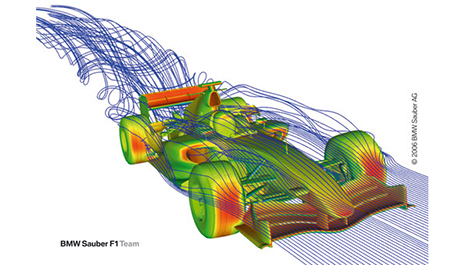Nov
11th
Stay connected Subscribe to our RSS feed
Despite years of development and research, aerodynamics remains some sort of black magic, especially in the case of race cars.
When running at speed on a road course, a Formula 1 car brakes, turns, accelerates, rides on kerbs, and follows other cars, all of which is far from being a perfect environment.
For that reason, testing the aerodynamic performance of an F1 car is an extremely complex task.
British publication F1-Monitor found out that a few years ago Honda F1 team [now Petronas Mercedes AMG] opted to use a water tank - more normally home to boat hulls - to test some characteristics of rear wing flows.
Analysing their track data, Honda wanted to find out if normalised downforce levels fell when the car was decelerating.
Honda's simulation methods could not be relied on to accurately predict such subtle transient flows, so the engineers decided to use a full-sized rear wing in a water towing tank.
The tank used for the test was 200m long, 10m wide and 5m deep. The rear wing assembly was placed in the tank, inverted and attached to a six-component load cell, 1m below the surface.
Water provided here a huge advantage over air, because of the differing densities.
The key benefit of such a test is the fact that water's higher density effectively allows flows to be simulated in slow motion. Roughly speaking, for the same dynamic pressure across the wing, the speed of water flow over the wing element need only be 1/30th of that if it were in air.
Honda conducted tests with this system to assess the rear wing flows under deceleration, and was able to conclude that the wing was operating as it should at all times.
When running at speed on a road course, a Formula 1 car brakes, turns, accelerates, rides on kerbs, and follows other cars, all of which is far from being a perfect environment.
For that reason, testing the aerodynamic performance of an F1 car is an extremely complex task.
 |
| CFD image of the air flow around the Sauber F1 car. (Image: Sauber AG) |
British publication F1-Monitor found out that a few years ago Honda F1 team [now Petronas Mercedes AMG] opted to use a water tank - more normally home to boat hulls - to test some characteristics of rear wing flows.
Analysing their track data, Honda wanted to find out if normalised downforce levels fell when the car was decelerating.
Honda's simulation methods could not be relied on to accurately predict such subtle transient flows, so the engineers decided to use a full-sized rear wing in a water towing tank.
The tank used for the test was 200m long, 10m wide and 5m deep. The rear wing assembly was placed in the tank, inverted and attached to a six-component load cell, 1m below the surface.
Water provided here a huge advantage over air, because of the differing densities.
The key benefit of such a test is the fact that water's higher density effectively allows flows to be simulated in slow motion. Roughly speaking, for the same dynamic pressure across the wing, the speed of water flow over the wing element need only be 1/30th of that if it were in air.
Honda conducted tests with this system to assess the rear wing flows under deceleration, and was able to conclude that the wing was operating as it should at all times.
 The latest auto news, reviews, prices, product and vehicle releases.
The latest auto news, reviews, prices, product and vehicle releases.